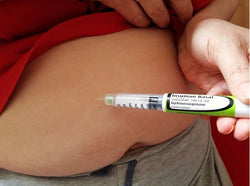Articles
What is the safe temperature range for insulin?

Published January 23 2023 BUSINESS MATTERS
Insulin is a peptide hormone that the body needs to maintain healthy blood sugar levels.
Peptide hormones, like insulin, are sensitive to temperature and can degrade to be no longer suitable for use. For those with diabetes who take insulin to help regulate their blood sugar, carefully keeping insulin at an ideal temperature range between 68 – 86°F (20-30°C) can make all the difference.
Why is it important to store insulin at the right temperature?
Peptides are the small units that make up proteins and work to keep our bodies healthy. Insulin is a vital peptide hormone that regulates blood sugar levels. When we eat, our body breaks down carbohydrates into glucose sugar for energy. Insulin’s job is to ensure we don’t have too much sugar in our blood, and it works to enter or exit the bloodstream to keep normal sugar levels, no matter what we’ve eaten.
Heat causes protein denaturation, which means it begins to break down, and frigid temperatures can damage peptides too. Extreme temperatures can cause proteins to change shape and, as a result, can form large clusters with one another. For these reasons, insulin may not work if it’s exposed to temperatures outside the safe range.
Tips for keeping insulin temperature range ideal at home and on the go
Insulin kept at a safe temperature range is suitable for about 30 days after opening. Insulin exposed to temperatures outside 58 – 86°F could break down, lose its strength and efficacy, and be potentially dangerous. To ensure your insulin is always safe, consider these tips when taking insulin at home or on the go.
Keeping safe insulin temperature at home
In general, it’s recommended to store insulin that is not opened and not in use in a cool place, such as a refrigerator or a cool bag, to protect it. . The best place to keep your unused insulin is in the fridge between 35°F to 40°F (1.5 – 4°C). Additionally, you want to keep your medication from getting pushed to the back of the refrigerator to where it’s colder. Unopened vials or pens have a 1-year expiration date if kept safe.
Insulin in use, however, should always be kept at room temperature. “In Use” means that you’ve removed the cap and punctured the rubber stopper on the vial with your syringe needle, or you’ve used the insulin pen for the first time.
Keeping safe insulin temperature on the go
When you are out of the house and away from room temperatures, always be aware of your environment’s temperature. Your car is never a good place to leave insulin because a car’s interior can easily be 20 degrees hotter than the outside air. Take your insulin with you if you plan to spend even a few minutes away from your car. It’s best to get a safe insulin temperature storage container that you can easily carry in your bag. When spending time outside, always put your bag underneath the shade and on a cold surface, like concrete. Additionally, if you’re traveling, always pack your insulin in your carry-on because you never know what conditions your checked luggage will endure.
Keeping safe insulin temperature in your body
Hot summer days can become dangerous for someone taking insulin if they are not well-hydrated. When you’re dehydrated, your body loses water. Consequently, your blood sugar levels rise, and you’ll most likely require a higher insulin dosage to control your blood sugar properly. Drinking lots of water when taking insulin is essential, especially when your body heats up.
Tools to keep insulin at the perfect room temperature
Today innovation for keeping insulin safe is growing, and more options for proper insulin storage are available. TempraMed’s VIVI Cap insulin storage device is one of the easiest and most effortless ways to keep insulin at a safe room temperature, especially on the go. The VIVI Cap storage device is a sophisticated cap with built-in temperature sensors that keeps your opened insulin below 84.2°F (29°C), even in temperatures above 100 degrees. The cap’s sensor system also stop cooling when it reaches temperatures below 78.8°F (26°C). The cap covers all refillable or disposable insulin pens and fits any lifestyle. If you rely on insulin daily, rely on the storage solutions for keeping insulin at a healthy temperature.
If you are managing your diabetes and need to take insulin regularly, this insulin travel case may well be the high-performance, on-the-go storage solution you need. Visit tempramed.com to purchase your own VIVI Cap diabetic travel case.




